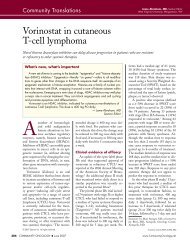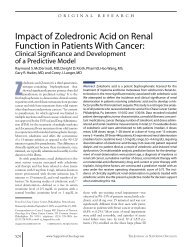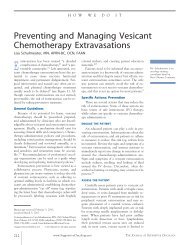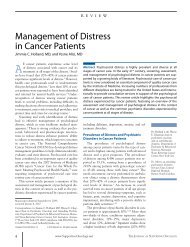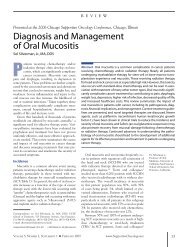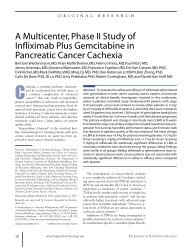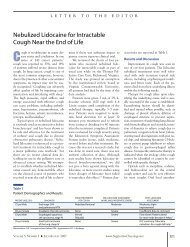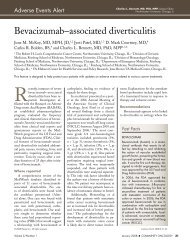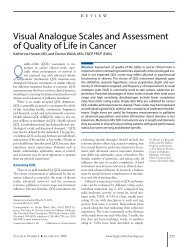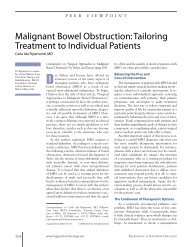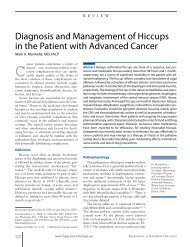Managing Bevacizumab-Related Toxicities in Patients with ...
Managing Bevacizumab-Related Toxicities in Patients with ...
Managing Bevacizumab-Related Toxicities in Patients with ...
Create successful ePaper yourself
Turn your PDF publications into a flip-book with our unique Google optimized e-Paper software.
<strong>Manag<strong>in</strong>g</strong> <strong>Bevacizumab</strong>-<strong>Related</strong> <strong>Toxicities</strong> <strong>in</strong> <strong>Patients</strong> <strong>with</strong> Colorectal Cancer<br />
Table 4<br />
<strong>Bevacizumab</strong>-Associated Wound Heal<strong>in</strong>g Complications (Non<strong>in</strong>fectious): Guidel<strong>in</strong>es for Dos<strong>in</strong>g<br />
and Schedule Modification<br />
Grade a DESCRIPTION MANAGEMENT<br />
Grade 1 Incisional separation of ≤ 25% of wound, no deeper than superficial fascia no action needed<br />
Grade 2 Incisional separation > 25% of wound <strong>with</strong> local care; asymptomatic hernia no action needed<br />
Grade 3 Symptomatic hernia <strong>with</strong>out evidence of strangulation; fascial disruption/dehiscence <strong>with</strong>out evisceration; Discont<strong>in</strong>ue bevacizumab<br />
primary wound closure or revision by operative <strong>in</strong>tervention <strong>in</strong>dicated; hospitalization or hyperbaric oxygen<br />
<strong>in</strong>dicated<br />
Grade 4 Symptomatic hernia <strong>with</strong> evidence of strangulation; fascial disruption <strong>with</strong> evisceration; major reconstruction Discont<strong>in</strong>ue bevacizumab<br />
flap, graft<strong>in</strong>g, resection, or amputation <strong>in</strong>dicated<br />
a<br />
Grade based on National Cancer Institute–Common Toxicity Criteria, v 3.0<br />
access catheter <strong>in</strong>sertion before bevacizumab treatment. An<br />
analysis of 534 patients who had catheters placed before treatment<br />
<strong>with</strong> bevacizumab and 5-FU or capecitab<strong>in</strong>e-based therapy<br />
showed that the risk of wound heal<strong>in</strong>g complications was<br />
low (1.1%). 12 There were no bleed<strong>in</strong>g events, and the catheterrelated<br />
thrombosis rate was 1.7% among all patients and 3.3%<br />
among those <strong>in</strong> whom the catheter was <strong>in</strong>serted <strong>with</strong><strong>in</strong> 7 days. 12<br />
In the past 2 years, we have had more than 18 patients receive<br />
bevacizumab <strong>with</strong><strong>in</strong> 24 hours after placement of a catheter, and<br />
not a s<strong>in</strong>gle complication has been witnessed to date.<br />
Further guidel<strong>in</strong>es regard<strong>in</strong>g bevacizumab-associated<br />
wound heal<strong>in</strong>g complications follow:<br />
• If a patient has been on bevacizumab, it should be held<br />
for 30–60 days before elective surgery, such as resection of metastasis<br />
or other procedures, is performed.<br />
• For emergency surgery, the patient, surgeon, and nurs<strong>in</strong>g<br />
staff should be aware of the possible risks of bevacizumab.<br />
• In general, clear communication <strong>with</strong> the surgeon is<br />
necessary, especially when a comb<strong>in</strong>ed-modality approach to<br />
care is be<strong>in</strong>g taken.<br />
GI PERFORATION<br />
Incidence. GI perforation was first observed <strong>in</strong> the pivotal<br />
phase III trial, <strong>in</strong> which six events occurred <strong>in</strong> the bevacizumab<br />
group (1.5%), compared <strong>with</strong> no events <strong>in</strong> the control group. 1<br />
S<strong>in</strong>ce then, similar rates of GI perforation have been observed<br />
<strong>in</strong> other large trials, as well as <strong>in</strong> the BRiTE study. 7<br />
The common cl<strong>in</strong>ical and radiologic manifestations of patients<br />
<strong>with</strong> GI perforations while on bevacizumab <strong>in</strong>clude subdiaphragmatic<br />
air on a kidney-ureter-bladder radiograph not<br />
Table 5<br />
Arterial Thromboembolism Events<br />
Associated <strong>with</strong> <strong>Bevacizumab</strong><br />
EVENT IFL + BEVACIZUMAB IFL + PLACEBO<br />
Cerebrovascular events 4 patients 0 patients<br />
Myocardial <strong>in</strong>farction 6 patients 3 patients<br />
Deep venous thrombosis 34 patients 19 patients<br />
Intra-abdom<strong>in</strong>al thrombosis 13 patients 5 patients<br />
IFL = ir<strong>in</strong>otecan/5-fluorouracil/leucovor<strong>in</strong><br />
requir<strong>in</strong>g surgery; a perforated stomach ulcer; colonic perforation<br />
associated <strong>with</strong> carc<strong>in</strong>omatosis or an abdom<strong>in</strong>al abscess;<br />
a small bowel obstruction, abscess, and perforated transverse<br />
colon; and bowel obstruction, ileal necrosis, and perforation.<br />
There seems to be no apparent pattern <strong>in</strong> the location of the<br />
perforation or its presentation.<br />
It is important to note that GI perforation can occur at any<br />
time while a patient is on therapy <strong>with</strong> bevacizumab. BRiTE<br />
data showed that half the perforations occur after 3 months<br />
of therapy and that almost 25% occur after 6 months of treatment.<br />
Similarly, <strong>in</strong> E3200, the <strong>in</strong>cidence of bowel perforations<br />
<strong>in</strong> each bevacizumab-conta<strong>in</strong><strong>in</strong>g arm was 1%. 6<br />
Risk Factors. GI perforation is a rare but potentially lifethreaten<strong>in</strong>g<br />
toxicity of bevacizumab. Sugrue et al evaluated<br />
possible risk factors for GI perforations <strong>in</strong> patients <strong>with</strong> metastatic<br />
CRC receiv<strong>in</strong>g bevacizumab plus chemotherapy <strong>in</strong> the<br />
BRiTE study. 13 The rate of GI perforations was similar among<br />
patients <strong>with</strong> or <strong>with</strong>out a basel<strong>in</strong>e history of peptic ulcer disease<br />
(1.8% vs 1.7%), diverticulosis (1.8% vs 1.7%), or chronic<br />
use of acetylsalicylic acid (ASA) or nonsteroidal anti-<strong>in</strong>flammatory<br />
drugs (0% vs 1.7%). 9 There appeared to be a higher<br />
<strong>in</strong>cidence of GI perforations <strong>in</strong> patients <strong>with</strong> a primary tumor<br />
<strong>in</strong>tact (3.3% vs 1.4%), a recent history of sigmoidoscopy or<br />
colonoscopy (2.6% vs 1.5%), or previous adjuvant radiation<br />
therapy (2.3% vs 1.6%). However, it is necessary to confirm<br />
these prelim<strong>in</strong>ary f<strong>in</strong>d<strong>in</strong>gs <strong>with</strong> multivariate analyses.<br />
The randomized phase III study also <strong>in</strong>dicated that the risk<br />
of GI perforation is <strong>in</strong>creased among patients who have surgery<br />
<strong>with</strong><strong>in</strong> 60 days before receiv<strong>in</strong>g bevacizumab and among patients<br />
who have surgery while receiv<strong>in</strong>g bevacizumab. 1 Therefore, a high<br />
<strong>in</strong>dex of suspicion should be reserved for patients <strong>with</strong> vomit<strong>in</strong>g,<br />
constipation, and abdom<strong>in</strong>al pa<strong>in</strong>. Any concern<strong>in</strong>g symptoms<br />
should be followed by physical exam<strong>in</strong>ation and radiographic imag<strong>in</strong>g.<br />
Furthermore, the treatment team’s nurses, physicians assistants,<br />
and fellows should be educated about GI perforations <strong>in</strong><br />
these patients to promptly attend to such an emergency.<br />
Treatment Guidel<strong>in</strong>es. The use of bevacizumab before and<br />
after surgery requires a multidiscipl<strong>in</strong>ary approach, <strong>with</strong> close,<br />
clear communication between the surgeon and the oncologist.<br />
For elective operations, bevacizumab should be discont<strong>in</strong>ued<br />
at least 30–60 days before a scheduled surgery. How<br />
long to hold bevacizumab is unknown and may be related to<br />
248 www.SupportiveOncology.net Th e Jo u r n a l o f Su p p o rt i v e On c o l o g y



